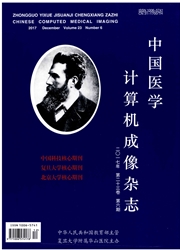

 中文摘要:
中文摘要:
AIM To evaluate the feasibility of low contrast mediumand radiation dose for hepatic computed tomography(CT) perfusion of rabbit VX2 tumor.METHODS: Eleven rabbits with hepatic VX2 tumorunderwent perfusion CT scanning with a 24-h intervalbetween a conventional tube potential (120 kVp)protocol with 350 mgI/mL contrast medium and filteredback projection, and a low tube potential (80 kVp)protocol with 270 mgI/mL contrast medium with iterativereconstruction. Correlation and agreement amongperfusion parameters acquired by the conventional andlow dose protocols were assessed for the viable tumorcomponent as well as whole tumor. Image noise andtumor-to-liver contrast to noise ratio during arterial andportal venous phases were evaluated.RESULTS: A 38% reduction in contrast medium dose(360.1 ± 13.3 mgI/kg vs 583.5 ± 21.5 mgI/kg, P 〈 0.001)and a 73% decrease in radiation dose (1898.5 mGy ?cm vs 6951.8 mGy ? cm) were observed. Interestingly,there was a strong positive correlation in hepatic arterialperfusion (r = 0.907, P 〈 0.001; r = 0.879, P 〈 0.001),hepatic portal perfusion (r = 0.819, P = 0.002; r = 0.831,P = 0.002), and hepatic blood flow (r = 0.945, P 〈 0.001;r = 0.930, P 〈 0.001) as well as a moderate correlation in hepatic perfusion index (r = 0.736, P = 0.01; r = 0.636,P = 0.035) between the low dose protocol with iterativereconstruction and the conventional protocol for theviable tumor component and the whole tumor. These twoimaging protocols provided a moderate but acceptableagreement for perfusion parameters and similar tumorto-liver CNR during arterial and portal venous phases(5.63 ± 2.38 vs 6.16 ± 2.60, P = 0.814; 4.60 ± 1.27 vs5.11 ± 1.74, P = 0.587).CONCLUSION: Compared with the conventionalprotocol, low contrast medium and radiation dose withiterative reconstruction has no significant influence onhepatic perfusion parameters for rabbits VX2 tumor.
 同期刊论文项目
同期刊论文项目
 同项目期刊论文
同项目期刊论文
 A Rim-Enhanced Mass with Central Cystic Changes on MR Imaging: How to Distinguish Breast Cancer from
A Rim-Enhanced Mass with Central Cystic Changes on MR Imaging: How to Distinguish Breast Cancer from 期刊信息
期刊信息
